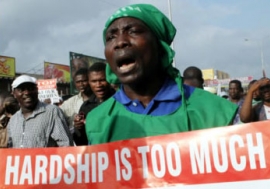Combating inequality in Africa
Workers in Burkina Faso are angry. Four times in 2005 and then again this May, the country’s trade unions shut down economic activity through a series of national general strikes. Thousands marched in the streets of that West African nation to protest low salaries, high prices, lost jobs and inadequate social benefits.
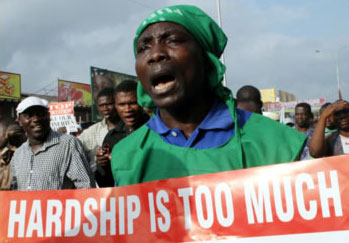 Nigerian labour protest: Workers across Africa are comparing their difficult conditions with the wealth of the elites.
Nigerian labour protest: Workers across Africa are comparing their difficult conditions with the wealth of the elites.Very often, the strikers contrasted their living standards with those of the elites. At one march in Bobo-Dioulasso, the main commercial city, union leader Bakary Millogo decried the workers’ “rampant pauperization” as opposed to the “scandalous and ostentatious” lifestyles of high government officials.
Burkina, commented a columnist for the independent daily L’Observateur Paalga, is “running the risk of a social explosion of unpredictable consequences.” The dangers are all the greater, he added, because endemic poverty exists alongside visible signs of wealth. “Some take a plane to get treated for hay fever,” he wrote, “while others die because they can’t afford malaria treatment.”
“Massive poverty and obscene inequality are such terrible scourges of our times . . . that they have to rank alongside slavery and apartheid as social evils.”
—Nelson Mandela, former president of South Africa
Father Balemans, an outspoken Catholic priest, affirmed that “the gap between the rich and the poor is widening ever more.” Such a situation is all the more insupportable, he continued, in the midst of relatively high economic growth rates, which have been “mainly for the rich.” The unions, in a joint declaration in April, affirmed: “The workers have a right to their share of the national wealth, which, according to the government, grew in 2005 by 7 per cent.”
Elsewhere in Africa, similar trends are also arousing growing concern. Many Africans think that inequalities are widening, with a small slice of the population getting richer as the ranks of the poor keep growing.
In Dakar, a boom in housing construction in the Senegalese capital “has led to the emergence of a middle class,” Ms. Fatimata Sy, director of a local social centre, recently told the Paris daily Le Monde. “Meanwhile, instability and poverty are gaining ground at the other end of the social ladder.”
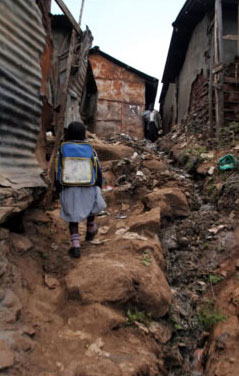 Kibera slum in Nairobi, Kenya: Policies should aim to shift resources to the poor.
Kibera slum in Nairobi, Kenya: Policies should aim to shift resources to the poor.A series of public-opinion surveys conducted in 2002-03 in 15 African countries by African and US researchers found that a big majority of people believe conditions are worsening. When asked by the researchers of the AfroBarometer project, as it is known, whether their governments’ economic policies were hurting most people and benefiting only a few, 61 per cent of the more than 23,000 people surveyed agreed. Only in three of the 15 countries (Lesotho, Mozambique and Namibia) did less than half the respondents think so.
‘Social evils’
In the 1980s and 1990s, when the performance of African economies was stagnant or declining, economists at the main international financial institutions were able to easily blame the continent’s widespread poverty on the lack of economic growth. Renewed growth, they argued, would eventually “trickle down” to improve everyone’s well-being, including the poor. But with African growth rates picking up markedly over the past decade while the proportion of Africans living on less than US$1 per day continues to rise, such arguments are facing renewed scepticism.
Meanwhile, the international community’s focus on achieving the Millennium Development Goals (MDGs) — one of which is to cut in half by 2015 the percentage of people in the world with incomes below $1 a day — is drawing greater attention to the various factors that influence poverty trends.
“Inequality does matter for achievement of the MDGs,” noted Mr. Arjan de Haan, a social development adviser with the UK’s Department for International Development, in an article in NEPAD Dialogue, a publication of the New Partnership for Africa’s Development (NEPAD), a continental plan adopted by African leaders in 2001. “Inequality — particularly in assets and gender — can even reduce rates of growth, hence indirectly limiting poverty reduction.”
“Ignoring inequality in the pursuit of development is perilous,” states UN Under-Secretary-General for Economic and Social Affairs José Antonio Ocampo. “Focusing exclusively on economic growth and income generation as a development strategy is ineffective, as it leads to the accumulation of wealth by a few and deepens the poverty of the many.” Besides impeding poverty reduction and achievement of the MDGs, Mr. Ocampo adds, failure to address inequalities means that “communities, countries and regions remain vulnerable to social, political and economic upheaval.”
The World Bank, which for years emphasized market liberalization as the best route to economic growth and poverty reduction, now also recognizes the role that inequalities play in hindering those goals. “Equity considerations need to be brought squarely into the centre of both diagnosis and policy,” says the Bank in the 2006 edition of its annual World Development Report, which this year focuses on the theme “Equity and Development.”
Addressing the problems of inequality, such analysts argue, requires introducing policies that specifically target the gaps and ensure that the poorest segments of the population are able to overcome their disadvantages.
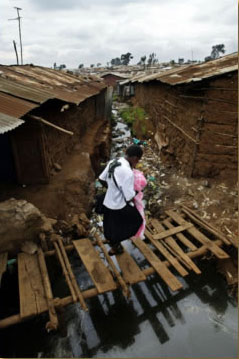 Many of Africa's poor are finding that the benefits of economic growth do not “trickle down” to them.
Many of Africa's poor are finding that the benefits of economic growth do not “trickle down” to them.Combating inequities globally and within countries is an ethical and moral imperative, former South African president Nelson Mandela has argued. “Massive poverty and obscene inequality,” he said in 2005, “are such terrible scourges of our times — times in which the world boasts breathtaking advances in science, technology, industry and wealth accumulation — that they have to rank alongside slavery and apartheid as social evils.”
Gaping divides
In recent decades, African and Latin American countries have had the highest levels of inequality in income, according to a 2005 study by the UN Department of Economic and Social Affairs (DESA), The Inequality Predicament. In both regions, “the situation deteriorated even further” in the 1980s and 1990s, said the report.
Such inequality meant that when economic downturn or disaster struck, those at the bottom of the income scale, the most vulnerable, were hurt disproportionately. And when national incomes rose, those at the top benefited the most, while the poor saw few gains, if any. Partly as a result, the number of people in sub-Saharan Africa living in absolute poverty (with incomes of less than $1 per day) doubled during those two decades, according to the DESA report. Their numbers climbed from 288 million in 1981 to 516 million in 2001 (see graph below).
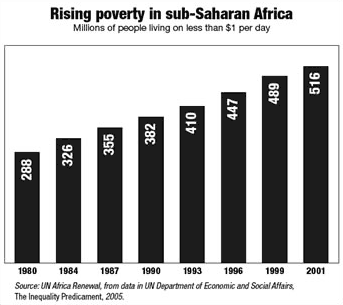
While South Asia also saw a rise in the total number of poor in that period, the region’s proportion of people living on less than $1 a day fell from 52 per cent to 31 per cent, marking progress towards the MDG target. But in sub-Saharan Africa, that share actually rose, from 42 per cent to 47 per cent.
Looking specifically at data on inequality, Mr. Branko Milanovic, a researcher at the World Bank, has detected some fluctuation. In the 1960s, he reports, the “Gini coefficient” — a common measure of income inequality — was on average 10 points higher in Africa than in the rest of the world combined. That difference diminished in the 1980s, but then in the 1990s “the gap opened up again.”
In some countries, the gaps are very wide. In Zambia, for example, the richest 10 per cent of the population earns a total income that is 42 times larger than that of the poorest 10 per cent. In Cameroon, a child born into the poorest 20 per cent of families is more than twice as likely to die before the age of five as one born into the top 20 per cent.
Absolute poverty and inequality are different concepts, notes the UN Development Programme (UNDP), “but they are intimately related. Disparities in life chances define prospects for escaping poverty.” Inequalities in access to healthcare, education or political rights, says the UNDP’s Human Development Report 2005, all make it much harder for people to struggle out of poverty.
Among other elements contributing to inequality and poverty, notes the report, are two broad conditions that strongly affect people’s incomes and access to social services. In most African countries, the urban-rural gap is especially wide. In Ghana, for example, the incidence of poverty in Accra, the capital, is only 2 per cent. But in the dry rural savannah regions in the north, it is 70 per cent. In Accra poverty has been declining, but in the savannah it has not budged.
Gender also is a prevalent factor (see box). Overall, women have access to fewer economic resources and have far less social and political power than do men, which greatly restricts their opportunities to climb out of poverty. In Guinea-Bissau, for instance, women have only about half the incomes of men and are only half as likely to be able to read or write.
Health and education disparities
Economic inequalities are only part of the picture. Across Africa, health, education, social welfare and many other aspects of human well-being are also marked by wide disparities. The wealthy receive the best schooling and medical care, while many of the poor simply do without. The poor education and health of those living in poverty in turn make it harder for them or their children to advance their economic position.
During the 1980s and 1990s, the market liberalization policies pushed by the International Monetary Fund (IMF), World Bank and other donor institutions led to drastic cuts in government-backed social programmes, notes the DESA report. That in turn “exacerbated inequalities.”
By the end of the 1990s, the disastrous impact of such cuts had become so glaring that policies shifted again, towards increasing social spending. While many argue that health and education spending in Africa is still far below what it should be, others point out that allocating more money alone will not solve all the problems. In Africa, notes Yvonne Tsikata, a scholar at the Economic and Social Research Foundation in Tanzania, “social sector spending is poorly targeted and often regressive. The poor are therefore benefiting much less than the level of social expenditures would suggest.”
In Guinea, according to a study by Florencia Castro-Leal and other World Bank researchers, 48 per cent of all people visiting hospitals and primary health facilities come from the richest fifth of the population. Those from the poorest fifth make up only 4 per cent of patients.
“Education,” notes the DESA report, “is typically seen as a means of narrowing inequalities.” However, across sub-Saharan Africa, 37 per cent of children did not go to primary school in 2001, the highest rate for any world region. Among females, the share was 41 per cent. Almost all children out of school are from poor families.
Over the past decade, African governments and donor institutions have been making a concerted push to significantly increase primary school enrolment rates, with some success. This is an important first step. But Ms. Tsikata, citing a study on Ghana, notes that increased primary schooling for the poor does very little to improve their immediate chances of escaping poverty. Most of the economic benefits of education do not kick in until students have reached at least a middle-school level.
Poverty amidst growth
For years, mainstream economists and development planners argued that the most important task facing African societies was to achieve macroeconomic stability, liberalize their economies and promote market-based policies that would stimulate economic growth. With growth, they maintained, there would be more resources for everyone, making it easier to reduce poverty. “A rising sea lifts all boats” was a favourite metaphor. But that view ignored how inequality seriously skews the distribution of resources. It therefore could not convincingly explain increases in poverty in the midst of growth.
Burkina, for example, has had an average annual growth rate over the past decade of around 5.6 per cent, one of the stronger and most sustained performances in Africa. But comprehensive household consumption surveys conducted in 1994, 1998 and 2003 detected a steady increase in the poverty rate. According to the country’s current Poverty Reduction Strategy Paper (PRSP), which drew on those surveys, the share of Burkinabè living below the poverty line rose from 44.5 per cent to 46.4 per cent during that period, with the sharpest increases in the cities and towns, which were hit hardest by job losses and high prices.
However, an assessment of Burkina’s PRSP by the staff of the IMF and World Bank maintained that the government’s figures showing an increase in poverty were “inconsistent” with the country’s growth rates. Believing that the problem lay in the numbers, the IMF/World Bank staff recalculated the poverty estimates for 1998 so that they were significantly higher — and therefore the most recent figure in 2003 appeared to reflect a relative decline.
Whatever the official statistics show, most Burkinabè believe strongly that poverty has been rising. A public opinion survey of 1,200 people across all social categories in August 2005 found that 86.5 per cent judged poverty to have worsened since 1998.
Inequality can be a major factor in poverty trends, admits the World Bank. Looking at all developing countries, the Bank finds that in low-income countries generally, each percentage point of growth brings a 4 per cent decline in the number of people living on less than $1 a day. However, it adds, that reduction is almost nonexistent in countries with high levels of income inequality.
Inequality may prevent the benefits of growth from reaching many of the poor, but the relationship also works in another direction, many experts say. “Extreme inequality is not just bad for poverty reduction — it is also bad for growth,” argues the UNDP report. “Poor people remain poor partly because they cannot borrow against future earnings to invest in production, the education of their children and assets to reduce their vulnerability. Insecure land rights and limited access to justice can create further barriers to investment. Deprived of public goods — such as information and legal rights — poor people are denied opportunities to contribute to growth.”
Inequalities in power
Inequality and politics also interact, often in negative ways. “Inequalities in income and human capabilities often reflect inequalities in political power,” observes the UNDP report. Poor people, women, rural populations and marginalized ethnic groups are disadvantaged in part because they usually are badly organized, have a weak political voice and in many countries are excluded from major areas of decision-making — especially those involving the distribution of economic and social resources. Unequal political power, adds the World Bank, “leads to the formation of institutions that perpetuate inequalities in power, status and wealth.”
Apartheid South Africa was a prime example. That country’s white supremacist political system denied the most basic rights to the African majority, who were disenfranchised, uprooted from their lands and confined to menial, low-paying jobs. Until the apartheid system was dismantled in the 1990s, race and income levels overlapped almost completely. The country is still struggling to overcome that legacy.
Mr. Milanovic, in his study of inequality in Africa, finds that ethnic divisions elsewhere in Africa also tend to reinforce economic and social inequalities to some extent. Ethnic “fragmentation,” he says, can contribute to inequality “by leading to a political fight over the spoils between the different ethnic groups.” Those groups with greater political power have an advantage over their competitors.
Inequality, in turn, can help fuel political instability. According to data compiled by the UN University, based on comprehensive household surveys in 25 African countries, Sierra Leone had the highest level of inequality in 1989, just before the outbreak of its decade-long civil war. The richest 20 per cent of the population accounted for more than 63 per cent of all expenditures, while the bottom 40 per cent had the resources to spend just a meagre 3.1 per cent.
After that war ended, surveys of former combatants found that many young people in Sierra Leone felt a sense of hopelessness, worsened by visible signs of elite wealth and power, that had contributed to their decision to take up arms.
Bringing back the state
Where extreme inequalities exist, markets, by themselves, do not lessen the gaps, argues the DESA report. The poorest and most marginalized lack the resources or political voice to influence the distribution of goods and services. Markets most benefit those with the greatest wealth and power. Therefore, the main means for overcoming inequity lie with state institutions that operate in the interests of the general public.
“The essential importance of the state transcends the logic of market forces,” says the report, “particularly in areas such as ethics, equality, social justice and the defence of rights intrinsic to citizenship, which are foreign to market mechanisms and institutions. . . . The state is also more effective in addressing risk, vulnerability, social exclusion, destitution and many other issues not amenable to microeconomic calculus.”
Many development experts now concur with the UN’s DESA that it is vital to end “the folly of privatizing state functions on a large scale” and to rebuild the public institutions and services that were weakened or dismantled in recent decades.
A big majority of Africans seem to agree. The surveys by the AfroBarometer project found that even though most Africans prefer a mixed economy, “their vision favours state intervention above market forces.” Across the 15 countries surveyed, an average of 70 per cent opposed reducing the size of the public sector.
Some officials still object that governments do not deliver services very effectively, citing their poor performance in the 1970s and early 1980s, when public sectors dominated. But while corruption, cronyism and mismanagement continue to plague many state institutions across Africa, the continent’s shift towards multiparty electoral systems and the proliferation of programmes to strengthen good governance have improved the accountability and capacity of those institutions.
Shifting policies
Among the tasks that public institutions can perform to help lessen inequality and realize “the progressively redistributive dimensions of development,” as DESA put it, are ensuring that all sectors of the population are socially and politically integrated, that roads and other infrastructure are extended to geographically remote areas and that economic policies emphasize activities that stimulate the creation of jobs.
National tax systems also should be made “moderately progressive,” adds the World Bank, so that the rich — many of whom now evade taxes — pay more, thus generating additional funds for poverty reduction and basic social services.
According to the study by Ms. Castro-Leal and her colleagues, a greater portion of spending within the health sector should shift from services that mainly benefit the wealthy to those used mostly by the poor. In Ghana, for example, two-thirds of all health expenditures now go to hospitals, located largely in the main towns, while poor Ghanaians generally go only to primary health clinics. And, the researchers add, since the poor often cannot afford to pay “user fees” in the clinics, such charges should only be applied to the better-off.
UNDP notes that when Uganda eliminated user fees at health facilities in 2001, public visits increased by 80 per cent, with half of the increase from the poorest fifth of the population.
Selective government subsidies can help ensure that the poor have access to other services as well. In the late 1990s, when Senegal first permitted private participation in urban water distribution, it accompanied those reforms with subsidies to provide standpipe connections in poor neighbourhoods.
In earlier decades, such government subsidies often were not targeted very well. Corrupt bureaucrats or those with high-level political connections were frequently able to divert the resources or benefits away from the intended recipients. With that experience in mind, the DESA report cautioned that targeting should be “community-based,” with local communities directly involved in identifying beneficiaries. Experiences with such an approach in some Latin American countries have demonstrated that community-based targeting not only promotes greater equality, but also strengthens local capacities more generally.
Some African countries have shown that it is possible to stimulate economic growth while at the same time reducing inequality and poverty. Mauritius is a frequent example. It has had a stable democratic system for decades, with relatively smooth changes in government and a balanced distribution of political power. The authorities took into account the interests of the country’s well-organized labour movement, while economic policies encouraged a diversification from sugar production into manufacturing. The government resisted external pressures in the 1980s to drastically cut public spending and maintained relatively large budget allocations for health, education, water, sanitation and housing assistance, drawing on taxes levied on sugar exporters.
“Poverty fell significantly” in Mauritius, notes Ms. Tsikata. “After an initial rise, inequality has fallen and social indicators have improved; they are now well above the average for Africa and indeed for middle-income countries.” According to World Bank estimates, Mauritius now has the lowest level of inequality among 30 sub-Saharan countries for which data is available.
In a recent essay on globalization and social justice, Amartya Sen, Nobel Prize laureate in economics, notes that much of the debate internationally has focused on whether inequalities are growing between the richer and poorer countries. He believes that they are and that those gaps must be addressed. But he also argues that in many poor countries local factors may have an even greater impact on poverty levels. “With good local policies — in education, health, property reform and access to credit, including microcredit for the least well-off — the entire economic system will improve.”
Redistributing assets to women
In Africa — indeed, across all societies — gender is one of the most common markers of inequality. Women, who generally have less political and social power than men, usually also have much lower incomes and far less access to productive resources and opportunities. “Nowhere,” notes the UN Development Programme's Human Development Report 2005, “are power inequalities and their consequences more clearly displayed than for women.”
Examples are numerous, across virtually all areas of activity. According to World Bank statistics, drawn from detailed household survey data, females have less than half the average number of years of education than do males in Benin, Burkina Faso, the Central African Republic, Guinea, Niger, Senegal, South Africa and Togo. In Chad, women on average complete less than a quarter of the schooling that men do.
Overall gender inequalities affect women's health and also the nutrition and health of their children. The Washington-based International Food Policy Research Institute calculates that if gender equity were achieved in sub-Saharan Africa, child malnutrition would fall by 3 per cent, with 1.7 million fewer malnourished children.
Social and economic inequalities also cut across gender lines, including in health indicators. In Togo, for instance, 91 per cent of women from the richest fifth of the population are attended by skilled health personnel during childbirth. Among women from the poorest fifth, that share drops to 25 per cent. In Mauritania, that gap is even wider, at 93 per cent and 15 per cent, respectively.
Among countries with low levels of human development, women often earn less than half of what men earn, including in Cameroon, Côte d'Ivoire, Eritrea, Ethiopia, Mauritania, Senegal and Sierra Leone. In a handful of countries, such as Kenya, women's earnings lag only slightly behind those of men.
Women have far less access to land and other productive assets. In Cameroon, women do more than three-quarters of agricultural work, but hold less than 10 per cent of all land titles. In Ghana, because women lack the social status to hold onto land during fallowing periods, they tend not to let the land rest, thus worsening soil degradation.
In addition to tackling inequalities in education, health and other areas, the World Bank, in this year's World Development Report, urges not only “redistributing assets” in favour of women, but also “redistributing access to capital, perhaps by promoting microcredit, strengthening women's land rights or access to jobs and welfare programmes, designing affirmative action programmes to break down stereotyping and improving access to justice systems.”
While better government policies are essential, women across Africa have also demonstrated a strong commitment to organizing themselves to advance their positions. In the poor neighbourhood of Grand Yoff, in Senegal's capital, Dakar, 53 women formed an economic association two years ago. They each put in CFA3,000 (about US$5.50) per month to buy tea in bulk, which they then repackaged and sold as individual tea bags. Now that the association has been able to accumulate some capital, it is in a position to make five-month loans of CFA 25,000 to ten women at a time, to help them expand and diversify their economic activities.










